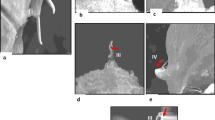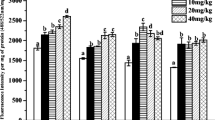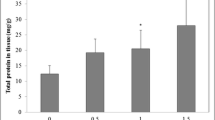Summary
Laboratory experiments were conducted to study the effects of the exposure to a sublethal concentration (500 p.p.m.) of lead on the ultrastructure and acid phosphatase compartmentalization of the chloragogenous tissue of earthworms, Eisenia foetida. For the cytochemical demonstration of acid phosphatase activity, lead and cerium were used as capturing agents. In both cases there was a change in the compartmentalization of acid phosphatase, the enzyme activity being localized within the chloragosomes in controls, but distributed throughout the cytosol in treated animals. In addition, acid phosphatase activity increased following lead exposure. At the ultrastructural level, disruption of the chloragosomal membranes, an increase in chloragosomal fusion processes and vesiculation of the cytoplasm were evident. Moreover, an enhanced release of chloragosomes to the extracellular space was found in lead-exposed worms.
Similar content being viewed by others
References
Behra, R., (1993) In vitro effects of cadmium, zinc and lead on calmodulin-dependent actions in Oncorhynchus mykiss, Mytilus sp. and Chlamydomonas reinhardtii. Arch. Environ. Contam. Toxicol. 24, 21–7.
Bowen, I. D., Worrill, N. A., Winters, C. A. & Mullarkey, K. (1988) The use of backscattered electron imaging, X-ray microanalysis and X-ray microscopy in demonstrating physiological cell death. Scan. Microsc. 2, 1453–62.
Brun, A. & Brunk, U. (1973) Lead induced injury on in vitro cultured rat fibroblasts. A histochemical study. Histochemie 35, 227–34.
Cajaraville, M. P., Marigómez, J. A. & Angulo, E. (1990) Ultrastructural study of the short-term toxic effects of naphthalene on the kidney of the marine prosobranch Littorina littorea. J. Invertbr. Pathol. 55, 215–24.
Cajaraville, M. P., Abascal, I., Etxeberria, M. & Marigómez, I. (1995) Lysosomes as cellular markers of environmental pollution: time-and dose-dependent responses of the digestive lysosomal system of mussels after petroleum hydrocarbon exposure. Env. Toxicol. Water Qual. 10, 1–8.
Cancio, I., ApGwynn, I., Ireland, M. P. & Cajaraville, M. P. (1995) Lysosomal origin of the chloragosomes in the chloragogenous tissue of the earthworm Eisenia foetida: cytochemical demonstration of acid phosphatase activity. Histochem. J. 27, 591–6.
Dallinger, R. & Prosi, F. (1988) Heavy metals in the terrestrial isopod Porcellio scaber Latreille. II. Subcellular fractionation of metal-accumulating lysosomes from hepatopancreas. Cell Biol. Toxicol. 4, 97–109.
DeDuve, C. (1969) The lysosome in retrospect. In Lysosomes in Biology and Pathology (edited by Dingle, J. T. & Fell, H. B.) Vol 1, pp. 3–40. Amsterdam: North-Holland Publishing Company.
Fischer, E. (1972) Uber die pigmente der chloragosomen und ihre histochemischen eigenschaften bei Lumbricus terrestris L. Acta Histochem. 42, 10–14.
Fischer, E. (1973a) The chloragosomes of lumbricidae as cation-exchangers (in vitro investigations). Acta Acad. Sci. Hung. 24, 157–63.
Fischer, E. (1973b) Histochemische Untersuchungen uber die metabolische aktivitat der chloragosomen von Lumbricus terrestris L. Acta Histochem. 46, 1–9.
Fischer, E. (1975) Structural basis of cation exchange, complex formation and redox properties in chloragosomes. Acta. Biol. Acad. Sci. Hung. 26, 75–84.
Fischer, E. (1976) Chloragocyte-eleocyte transformation induced by benomyl and carbofuran toxication of earthworms (Oligochaeta). Zool. Anz. 197, 225–33.
Fischer, E. (1989) Effects of atrazine and paraquat-containing herbicides on Eisenia foetida (Annelida, Oligochaeta). Zool. Anz. 223, S 291–300.
Fischer, E. & Horvath, I. (1976a) The effect of carbofuran toxication on the chloragogen tissue of Tubifex tubifex Mull. (Oligochaeta). Z. Mikrosk. Anat. Forsch. 4, 720–36.
Fischer, E. & Horvath, I. (1976b) In vivo accumulation and discharge of azine, thiazine and xanthene dyes and their effects on the chloragogen cells of Lumbricidae (Oligochaeta). Acta Biol. Sci. Hung. 28, 33–47.
Fischer, E. & Molnár, L. (1992) Environmental aspects of the chloragogenous tissue of earthworms. Soil. Biol. Biochem. 24, 1723–7.
George, S. G. (1983) Heavy metal detoxication in the mussel Mytilus edulis — composition of cadmium containing kidney granules (tertiary lysosomes). Comp. Biochem. Physiol. 76C, 53–7.
George, S. G., Pirie, B. J. S., Cheyne, A. R., Coombs, T. L. & Grant, T. P. (1978) Detoxification of metals by marine bivalves: an ultrastructural study of the compartmentation of copper and zinc in the oyster Ostrea edulis. Mar. Biol. 45, 147–56.
Gomori, G. (1952) Microscopic Histochemistry: Principles and Practice. Chicago: The University of Chicago Press.
Halliwell, B. & Gutteridge, J. M. (1984) Oxygen-toxicity, oxygen radicals, transition-metals and disease. Biochem. J. 219, 1–14.
Ireland, M. P. (1975) Distribution of Pb, Zn, and Ca in Dendrobaena rubida (Oligochaeta) living in soil contaminated by a base metal mining in Wales. Comp. Biochem. Physiol. 52B, 552–5.
Ireland, M. P. (1978) Heavy-metal binding-properties of earthworm chloragosomes. Acta. Biol. Sci. Hung. 29, 385–94.
Ireland, M. P. (1983) Heavy metal uptake and tissue distribution in earthworms. In Earthworm Ecology (edited by Satchell, J. E.), pp. 247–65. London: Chapman & Hall.
Ireland, M. P. & Richards, K. S. (1977) The occurrence and localisation of heavy metals and glycogen in the earthworms Lumbricus rubellus and Dendrobaena rubida from a heavy metal site. Histochemistry 51, 153–66.
Jamieson, B. G. M. (1992) Oligochaeta. In Microscopic Anatomy of Invertebrates, 7, Annelida (edited by Harrison, F. W. & Gardiner, S. L.), pp. 217–322. New York: Wiley-Liss.
Lowe, D. M., Moore, M. N. & Clarke, K. R. (1981) Effects of oil on digestive cells in mussels: quantitative alteration in cellular and lysosomal structure. Aquat. Toxicol. 1, 213–26.
Mahaffey, K. R. (1987) Factors influencing biological responses to chemicals. In Mechanisms of Cell Injury: Implications for Human Health (edited by FowlerB. A.), pp. 315–31. Chichester: John Wiley & Sons.
Marigómez, J. A., Vega, M. M., Cajaraville, M. P. & Angulo, E. (1989) Quantitative responses of the digestive-lysosomal system of winkles to sublethal concentrations of cadmium. Cell Mol. Biol. 35, 555–62.
Marigómez, J. A., Cajaraville, M. P. & Angulo, E. (1990a) Cellular cadmium distribution in the common winkle Littorina littorea (L.) determined by X-ray microprobe analysis and histochemistry. Histochemistry 94, 191–9.
Marigómez, J. A., Cajaraville, M. P., Angulo, E. & Moya, J. (1990b) Ultrastructural alterations in the renal epithelium of cadmium-treated Littorina littorea (L.). Arch. Environ. Contam. Toxicol. 19, 863–71.
Marzabadi, M. R. & Jones, C. B. (1992) Heavy metals and lipofuscinogenesis. A study on myocardial cells cultured under varying oxidative stress. Mech. Ageing Dev. 66, 159–71.
Moment, G. B. (1974) The possible roles of coelomic cells and their yellow pigment in annelid regeneration and aging. Growth 38, 209–18.
Morgan, A. J. (1982) The elemental composition of the chloragosomes of nine species of British earthworms in relation to calciferous gland activity. Comp. Biochem. Physiol. 73A, 207–16.
Morgan, A. J. & Morris, B. (1982) The ultrastructure and intracellular compartmentation of cadmium, lead, zinc and calcium in two earthworm species (Dendrobaena rubida and Lumbricus rubellus) living in highly contaminated soil. Histochemistry 75, 269–85.
Morgan, A. J., Morgan, J. E., Turner, M., Winter, C. & Yarwood, A. (1993) Metal relationships of earthworms. In Ecotoxicology of Metals in Invertebrates (edited by Dallinger, R. & Rainbow, P. S.), pp. 333–58. Boca Raton, Florida: Lewis Publishers.
Morgan, J. E. & Morgan, A. J. (1988a) Calcium-lead interactions involving earthworms. Part I: the effect of exogenous calcium and lead accumulation by earthworms under field and laboratory conditions. Environ. Pollut. 54, 41–55.
Morgan, J. E. & Morgan, A. J. (1988b) Earthworms as biological monitors of cadmium, copper, lead and zinc in metalliferous soils. Environ. Pollut. 54, 123–38.
Morgan, J. E. & Morgan, A. J. (1989) The effect of lead incorporation on the elemental composition of earthworm (Annelida, Oligochaeta) chloragosome granules. Histochemistry 92, 237–41.
Pickwell, G. V. & Steinert, S. A. (1984) Serum biochemical and cellular responses to experimental cupric ion challenge in mussels. Mar. Environ. Res. 14, 245–65.
Pipe, R. K. & Moore, M. N. (1986) Arylsulphatase activity associated with phenanthrene induced digestive cell deletion in the marine mussel Mytilus edulis. Histochem. J. 18, 557–64.
Prentø, P. (1979) Metals and phosphate in the chloragosomes of Lumbricus terrestris and their possible physiological significance. Cell Tiss. Res. 196, 123–34.
Regoli, F. (1992) Lysosomal responses as a sensitive stress index in biomonitoring heavy metal pollution. Mar. Ecol. Prog. Ser. 84, 63–9.
Ribarov, S. R. & Benov, L. C. (1981) Relationship between the hemolytic action of heavy metals and lipid peroxidation. Biochim. Biophys. Acta 640, 721–6.
Richards, K. S. & Ireland, M. P. (1978) Glycogen-lead relationship in the earthworm Dendrobaena rubida from a heavy metal site. Histochemistry, 56, 55–64.
Robinson, J. M. & Karnovsky, M. J. (1983) Ultrastructural localization of several phosphatases with cerium. J. Histochem. Cytochem. 31, 1197–208.
Roots, B. I. & Johnston, P. V. (1966) The lipids and pigments of the chloragosomes of the earthworm Lumbricus terrestris L. Comp. Biochem. Physiol. 17, 285–8.
Somashekaraiah, B. V., Padmaja, K. & Prasad, A. R. (1992) Lead-induced lipid peroxidation and auto-oxidant defense components of developing chick embryos. Free Rad. Biol. Med. 13, 107–14.
Sternlieb, I. & Goldfischer, S. (1976) Heavy metals in lysosomes. In Lysosomes in Biology and Pathology, 5 (edited by Dingle, J. T. & Dean, R. T.), pp. 185–200. Amsterdam: North-Holland Publishing Company.
Sunderman, F. W.Jr (1986) Metals and lipid peroxidation. Acta Pharmacol. Toxicol. 59 S7, 248–55.
Varute, A. T. & More, N. K. (1972) Are chloragosomes in earthworm chloragogen cells lysosomes? Acta Histochem. 44, 144–51.
Varute, A. T. & More, N. K. (1973) Lysosomal acid hydrolases in the chloragogen cells of earthworms. Comp. Biochem. Physiol. 45A, 607–35.
Viarengo, A. (1989) Heavy metals in marine invertebrates: mechanisms of regulation and toxicity at the cellular level. CRC Crit. Rev. in Aquat. Sci. 1, 295–317.
Viarengo, A. (1994) Heavy metal cytotoxicity in marine organisms: effects on Ca2+ homeostasis and possible alteration of signal transduction pathways. In Advances in Comparative and Environmental Physiology. Vol. 20, pp. 85–110. Berlin, Heidelberg: Springer-Verlag.
Viarengo, A., Canesi, L., Fertica, M., Poli, G., Moore, M. N. & Orunesu, M. (1990) Heavy metal effects on lipid peroxidation in the tissues of Mytilus galloprovincialis Lam. Comp. Biochem. Physiol. 97C, 37–42.
Weeden, R. P. & DeBroe, M. E. (1987) The role of chemical exposure in irreversible renal injury in humans. In Mechanisms of Cell Injury: Implications for Human Health (edited by Fowler, B. A.), pp. 333–51. Chichester: John Wiley & Sons.
Whitehouse, R. H. & Grove, A. J. (1943) Dissection of the Earthworm. London: University Tutorial Press.
Author information
Authors and Affiliations
Rights and permissions
About this article
Cite this article
Cancio, I., ap Gwynn, I., Ireland, M.P. et al. The effect of sublethal lead exposure on the ultrastructure and on the distribution of acid phosphatase activity in chloragocytes of earthworms (Annelida, Oligochaeta). Histochem J 27, 965–973 (1995). https://doi.org/10.1007/BF00175571
Received:
Revised:
Issue Date:
DOI: https://doi.org/10.1007/BF00175571




